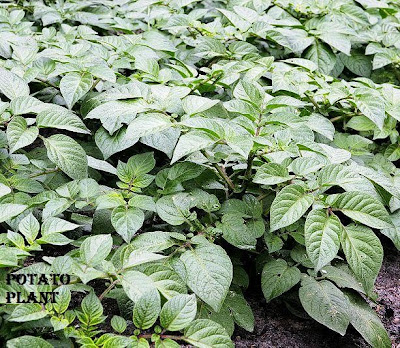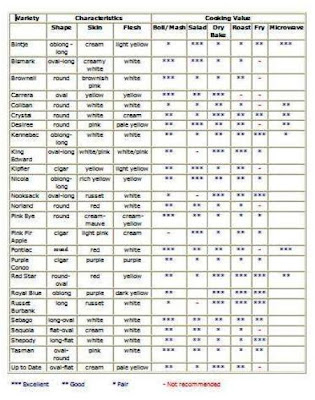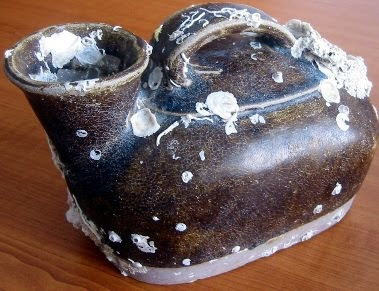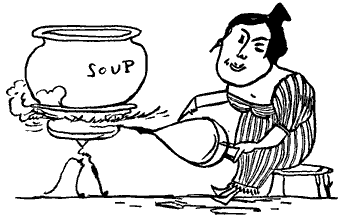 T
The potato is a starchy, tuberous crop from the perennial Solanum tuberosum of the Solanaceae family (also known as the nightshades). The word potato may refer to the plant as well as the tuber. Potatoes are believed to be from Peru where it was cultivated as long as 10,000 years ago. Potatoes are the world's fourth largest food crop, after rice, wheat and maize. The name Potato comes from the Spanish word ‘patata’ which is compounded from two south american words (of different dialects) – papa and batata.

Although Peru is the birthplace of the potato, over 99 per cent of all cultivated potatoes worldwide are descendants of a subspecies indigenous to south-central Chile.

The potato was introduced to Europe in 1536 and subsequently by European mariners to the rest of the world. Once established in Europe, the potato soon became an important food staple and field crop. Lack of genetic diversity, due to the fact that very few varieties were initially introduced elsewhere in the world, left the crop vulnerable to diseases in the introduced countries. In 1845, a plant disease known as late blight, spread rapidly through western Ireland, resulting in crop failures that led to the Great Irish Famine.

China is now the world's largest potato producing country, and nearly a third of the world's potatoes are harvested in China and India. Potatoes are now a staple in nearly all cuisines throughout the world.
TYPES OF POTATOES AVAILABLE IN AUSTRALIA AND COOKING GUIDES
ATLANTIC:
An attractive potato with white skin and flesh. Good for boiling and baking, superb for frying and chips.
BANANA:
Yellow, banana-shaped, waxy-type tubers with firm texture that have wonderful flavour baked, boiled and steamed. Perfect for salads.
BINTJE:
A waxy potato from the Netherlands. It is creamy with a yellow flesh and ideal for potato salads.
BISMARK:
Ideal for roasting or frying when you want crispy skins. Available only around mid Summer.
BROWNELL:
Brownish-pink tubers and white flesh. It is excellent for boiling, especially when new, and for mashing and chips when more mature. Not recommended for baking. Stores very well.
COLIBAN:
A white potato ideal for mashing or roasting.
DELAWARE:
A white potato ideal for roasting and chipping.
DESIREE:
A pink skin and yellow flesh potato ideal for boiling.
DUTCH CREAMS:
Originally from Holland but grown widely in Australia; the best hailing from Tasmania. Best boiled and eaten with a little salt.
RUSSET BURBANK:
White fleshed potato good for chips, roasting and mashing.
JERSEY ROYAL:
Cream skined and white flesh potao great for boiling whole or in potato salads.
KENNEBEC:
Creamy skin and white flesh - the old staple potato.
KING EDWARD:
White flesh. Great for roasting, boiling and mashing.
KIPFLER (OR GERMAN FINGER POTATO):
A waxy, finger shaped with creamy-coloured flesh. Great boiled, steamed and in potato salads and for presentation purposes.
LATONA:
Yellow skin and flesh. Good for boiling and mashing.
LUSTRE:
An oval, white-skinned and white-fleshed potato. Excellent flavour. Good for baking and roasting, makes great chips. Especially recommended for boiling. Very similar to Kennebec.
NADINE:
Creamy-coloured skin and flesh. A general purpose potato except for chips.
NICOLA:
Yellow flesh. Excellent for mashing and gnocchi and good for boiling, chips and roasting. It has a very buttery flavour.
OTWAY REDS:
Good all rounder.
PATRONE:
Ideal for roast or salads. Waxy, very firm and never fall apart. Light yellow flesh and skin. Great for curries.
PINK EYE (OR SOUTHERN GOLD):
A cold climate potato, so those from Southern Tasmania are usually the best. A very nutty flavour. Good for roasting, boiling and salads.
PINK FIR:
The ultimate salad potato. They are very waxy and very firm.
PONTIAC:
Pink skin and white flesh A good general purpose spud.
PURPLE CONGO:
Originating from Peru, it has a subtle lavender flesh which can add a decorative touch to potato salads or gnocchi. No need to peel.
RED NORLAND:
Early red potato with excellent flavoured white flesh. A very versatile potato, best for salad, boiling and mashing.
ROYAL BLUE:
Purple skin and yellow flesh. Good for roasting, mashing and chips.
RUBY-LOU:
Creamy texture, white flesh, rosy skin.
RUSSET BURBANKS (IDAHO):
A good frying potato and good all-rounder. Used by McDonald's throughout the world for its French fries.
SAPPHIRE:
A spectacular purple potato with rich purple flesh that maintains its colour when cooked. Makes the most striking mashed potato.
SEBAGO:
Cream skin and white flesh. Good for chips, mashing and general purpose.
SOUTHERN GOLD:
A waxy potato with a yellow flesh.
SPUNTA:
A yellow fleshed potato that is a good all rounder and good for potato salads.
SYMFONIA:
Red skin and yellow flesh. Good for roasting, mashing and chips.
TASMAN:
Tasman is a useful all-purpose with white flesh. Great for boiling, salad, mashing, chips and baking.
TOOLANGI DELIGHT:
With a pure white flesh and a creamy texture they are a very good general purpose spud.
Named after the Department of Agriculture's potato research station. Good mashed or in their jackets in oven. The purple skin will rub off with water.
UP-TO-DATE:
An heirloom Scottish variety, introduced in 1894, with a high reputation for its baking quality. It's also good for boiling, mash and chips. The tubers are flat and oval, with creamy-white skin and cream flesh.
YUKON GOLD:
Developed in Canada and not readily available in Australia, the Yukon Gold is a yellow potato similar to the Bintje but not quite as flavourful. A useful general purpose potato.

IN SUMMARY:
For mashing: Nicolas, Desirees, Bintjes, King Edwards, Russet Burbanks and Toolangi Delight.
For potato salads: waxy varieties such as Pink Fir, Kipfler, Patrone and Pink Eyes.
For roasting or baking: King Edwards, Delaware and Up-To-Date.
For chips (or French Fries): low sugar and floury varieties such as Sebago, Russet Burbanks and Bintje.
For boiling, steaming stews and curries: waxy varieties such as Patrone and Desiree.
For gnocchi: Nicolas.
All purpose: Tasman, Russet Burbanks and King Edward.
Source: Wikipedia, White Hat Cookbook and Tasmania Gourmet Potatoes












































